13.2. 全排列问题¶
全排列问题是回溯算法的一个典型应用。它的定义是在给定一个集合(如一个数组或字符串)的情况下,找出这个集合中元素的所有可能的排列。
下表列举了几个示例数据,包括输入数组和对应的所有排列。
| 输入数组 | 所有排列 |
|---|---|
| \([1]\) | \([1]\) |
| \([1, 2]\) | \([1, 2], [2, 1]\) |
| \([1, 2, 3]\) | \([1, 2, 3], [1, 3, 2], [2, 1, 3], [2, 3, 1], [3, 1, 2], [3, 2, 1]\) |
13.2.1. 无相等元素的情况¶
Question
输入一个整数数组,数组中不包含重复元素,返回所有可能的排列。
从回溯算法的角度看,我们可以把生成排列的过程想象成一系列选择的结果。假设输入数组为 \([1, 2, 3]\) ,如果我们先选择 \(1\) 、再选择 \(3\) 、最后选择 \(2\) ,则获得排列 \([1, 3, 2]\) 。回退表示撤销一个选择,之后继续尝试其他选择。
从回溯代码的角度看,候选集合 choices 是输入数组中的所有元素,状态 state 是直至目前已被选择的元素。请注意,每个元素只允许被选择一次,因此 state 中的所有元素都应该是唯一的。
如下图所示,我们可以将搜索过程展开成一个递归树,树中的每个节点代表当前状态 state 。从根节点开始,经过三轮选择后到达叶节点,每个叶节点都对应一个排列。
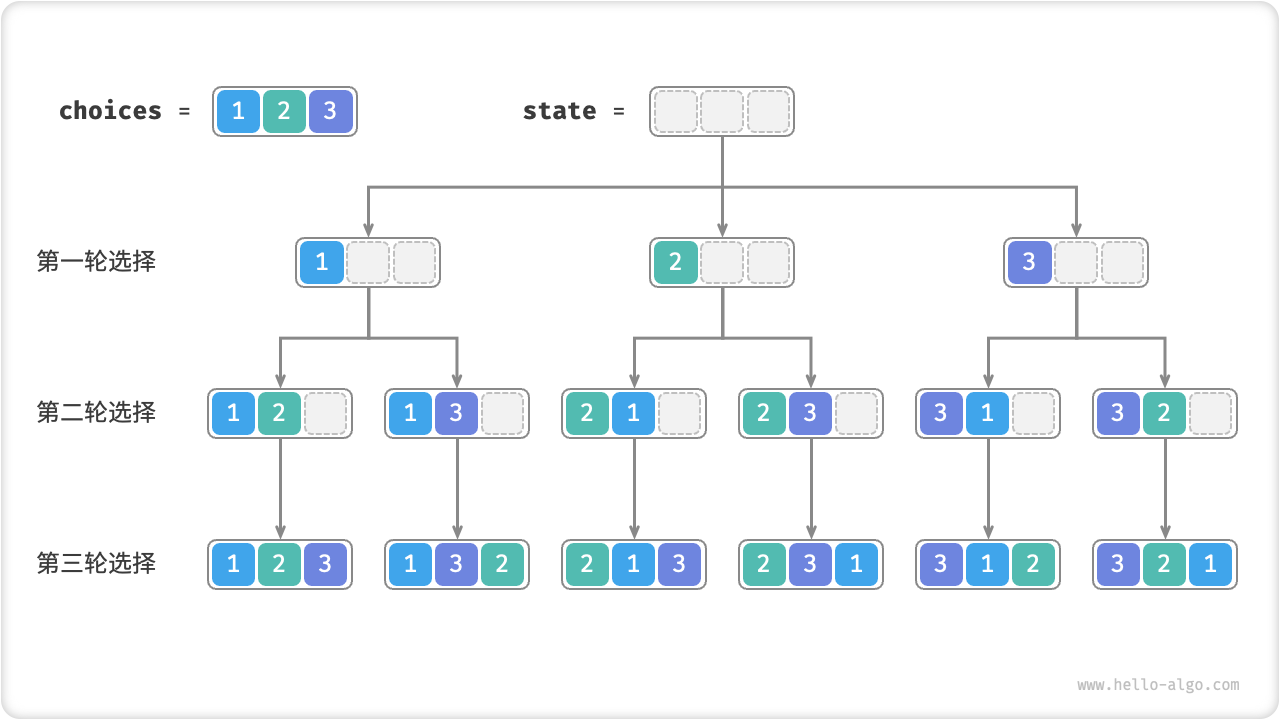
Fig. 全排列的递归树
重复选择剪枝¶
为了实现每个元素只被选择一次,我们考虑引入一个布尔型数组 selected ,其中 selected[i] 表示 choices[i] 是否已被选择。剪枝的实现原理为:
- 在做出选择
choice[i]后,我们就将selected[i]赋值为 \(\text{True}\) ,代表它已被选择。 - 遍历选择列表
choices时,跳过所有已被选择过的节点,即剪枝。
如下图所示,假设我们第一轮选择 1 ,第二轮选择 3 ,第三轮选择 2 ,则需要在第二轮剪掉元素 1 的分支,在第三轮剪掉元素 1, 3 的分支。
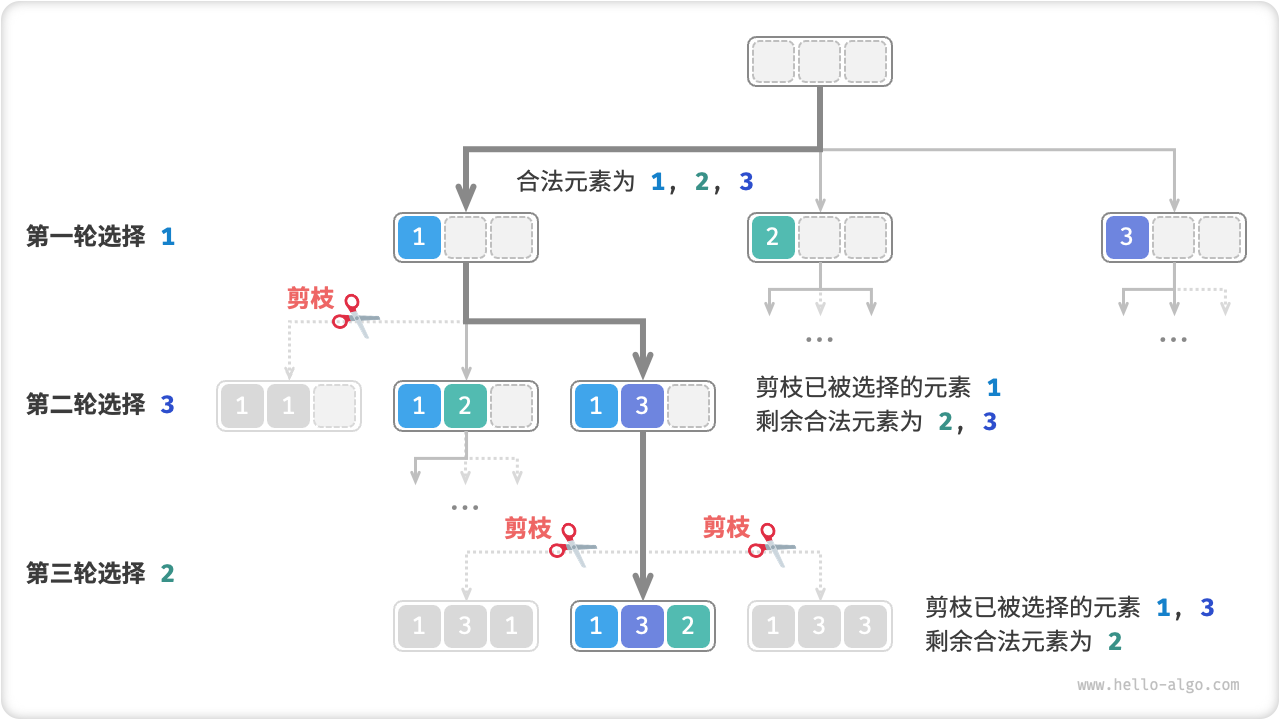
Fig. 全排列剪枝示例
观察上图发现,该剪枝操作将搜索空间大小从 \(O(n^n)\) 降低至 \(O(n!)\) 。
代码实现¶
想清楚以上信息之后,我们就可以在框架代码中做“完形填空”了。为了缩短代码行数,我们不单独实现框架代码中的各个函数,而是将他们展开在 backtrack() 函数中。
/* 回溯算法:全排列 I */
void backtrack(List<Integer> state, int[] choices, boolean[] selected, List<List<Integer>> res) {
// 当状态长度等于元素数量时,记录解
if (state.size() == choices.length) {
res.add(new ArrayList<Integer>(state));
return;
}
// 遍历所有选择
for (int i = 0; i < choices.length; i++) {
int choice = choices[i];
// 剪枝:不允许重复选择元素 且 不允许重复选择相等元素
if (!selected[i]) {
// 尝试:做出选择,更新状态
selected[i] = true;
state.add(choice);
// 进行下一轮选择
backtrack(state, choices, selected, res);
// 回退:撤销选择,恢复到之前的状态
selected[i] = false;
state.remove(state.size() - 1);
}
}
}
/* 全排列 I */
List<List<Integer>> permutationsI(int[] nums) {
List<List<Integer>> res = new ArrayList<List<Integer>>();
backtrack(new ArrayList<Integer>(), nums, new boolean[nums.length], res);
return res;
}
/* 回溯算法:全排列 I */
void backtrack(vector<int> &state, const vector<int> &choices, vector<bool> &selected, vector<vector<int>> &res) {
// 当状态长度等于元素数量时,记录解
if (state.size() == choices.size()) {
res.push_back(state);
return;
}
// 遍历所有选择
for (int i = 0; i < choices.size(); i++) {
int choice = choices[i];
// 剪枝:不允许重复选择元素 且 不允许重复选择相等元素
if (!selected[i]) {
// 尝试:做出选择,更新状态
selected[i] = true;
state.push_back(choice);
// 进行下一轮选择
backtrack(state, choices, selected, res);
// 回退:撤销选择,恢复到之前的状态
selected[i] = false;
state.pop_back();
}
}
}
/* 全排列 I */
vector<vector<int>> permutationsI(vector<int> nums) {
vector<int> state;
vector<bool> selected(nums.size(), false);
vector<vector<int>> res;
backtrack(state, nums, selected, res);
return res;
}
def backtrack(
state: list[int], choices: list[int], selected: list[bool], res: list[list[int]]
):
"""回溯算法:全排列 I"""
# 当状态长度等于元素数量时,记录解
if len(state) == len(choices):
res.append(list(state))
return
# 遍历所有选择
for i, choice in enumerate(choices):
# 剪枝:不允许重复选择元素
if not selected[i]:
# 尝试:做出选择,更新状态
selected[i] = True
state.append(choice)
# 进行下一轮选择
backtrack(state, choices, selected, res)
# 回退:撤销选择,恢复到之前的状态
selected[i] = False
state.pop()
def permutations_i(nums: list[int]) -> list[list[int]]:
"""全排列 I"""
res = []
backtrack(state=[], choices=nums, selected=[False] * len(nums), res=res)
return res
/* 回溯算法:全排列 I */
func backtrackI(state *[]int, choices *[]int, selected *[]bool, res *[][]int) {
// 当状态长度等于元素数量时,记录解
if len(*state) == len(*choices) {
newState := append([]int{}, *state...)
*res = append(*res, newState)
}
// 遍历所有选择
for i := 0; i < len(*choices); i++ {
choice := (*choices)[i]
// 剪枝:不允许重复选择元素 且 不允许重复选择相等元素
if !(*selected)[i] {
// 尝试:做出选择,更新状态
(*selected)[i] = true
*state = append(*state, choice)
// 进行下一轮选择
backtrackI(state, choices, selected, res)
// 回退:撤销选择,恢复到之前的状态
(*selected)[i] = false
*state = (*state)[:len(*state)-1]
}
}
}
/* 全排列 I */
func permutationsI(nums []int) [][]int {
res := make([][]int, 0)
state := make([]int, 0)
selected := make([]bool, len(nums))
backtrackI(&state, &nums, &selected, &res)
return res
}
/* 回溯算法:全排列 I */
function backtrack(state, choices, selected, res) {
// 当状态长度等于元素数量时,记录解
if (state.length === choices.length) {
res.push([...state]);
return;
}
// 遍历所有选择
choices.forEach((choice, i) => {
// 剪枝:不允许重复选择元素 且 不允许重复选择相等元素
if (!selected[i]) {
// 尝试:做出选择,更新状态
selected[i] = true;
state.push(choice);
// 进行下一轮选择
backtrack(state, choices, selected, res);
// 回退:撤销选择,恢复到之前的状态
selected[i] = false;
state.pop();
}
});
}
/* 全排列 I */
function permutationsI(nums) {
const res = [];
backtrack([], nums, Array(nums.length).fill(false), res);
return res;
}
/* 回溯算法:全排列 I */
function backtrack(
state: number[],
choices: number[],
selected: boolean[],
res: number[][]
): void {
// 当状态长度等于元素数量时,记录解
if (state.length === choices.length) {
res.push([...state]);
return;
}
// 遍历所有选择
choices.forEach((choice, i) => {
// 剪枝:不允许重复选择元素 且 不允许重复选择相等元素
if (!selected[i]) {
// 尝试:做出选择,更新状态
selected[i] = true;
state.push(choice);
// 进行下一轮选择
backtrack(state, choices, selected, res);
// 回退:撤销选择,恢复到之前的状态
selected[i] = false;
state.pop();
}
});
}
/* 全排列 I */
function permutationsI(nums: number[]): number[][] {
const res: number[][] = [];
backtrack([], nums, Array(nums.length).fill(false), res);
return res;
}
/* 回溯算法:全排列 I */
void backtrack(vector *state, vector *choices, vector *selected, vector *res) {
// 当状态长度等于元素数量时,记录解
if (state->size == choices->size) {
vector *newState = newVector();
for (int i = 0; i < state->size; i++) {
vectorPushback(newState, state->data[i], sizeof(int));
}
vectorPushback(res, newState, sizeof(vector));
return;
}
// 遍历所有选择
for (int i = 0; i < choices->size; i++) {
int *choice = malloc(sizeof(int));
*choice = *((int *)(choices->data[i]));
// 剪枝:不允许重复选择元素 且 不允许重复选择相等元素
bool select = *((bool *)(selected->data[i]));
if (!select) {
// 尝试:做出选择,更新状态
*((bool *)selected->data[i]) = true;
vectorPushback(state, choice, sizeof(int));
// 进行下一轮选择
backtrack(state, choices, selected, res);
// 回退:撤销选择,恢复到之前的状态
*((bool *)selected->data[i]) = false;
vectorPopback(state);
}
}
}
/* 全排列 I */
vector *permutationsI(vector *nums) {
vector *iState = newVector();
int select[3] = {false, false, false};
vector *bSelected = newVector();
for (int i = 0; i < nums->size; i++) {
vectorPushback(bSelected, &select[i], sizeof(int));
}
vector *res = newVector();
// 前序遍历
backtrack(iState, nums, bSelected, res);
return res;
}
/* 回溯算法:全排列 I */
void backtrack(List<int> state, int[] choices, bool[] selected, List<List<int>> res) {
// 当状态长度等于元素数量时,记录解
if (state.Count == choices.Length) {
res.Add(new List<int>(state));
return;
}
// 遍历所有选择
for (int i = 0; i < choices.Length; i++) {
int choice = choices[i];
// 剪枝:不允许重复选择元素 且 不允许重复选择相等元素
if (!selected[i]) {
// 尝试:做出选择,更新状态
selected[i] = true;
state.Add(choice);
// 进行下一轮选择
backtrack(state, choices, selected, res);
// 回退:撤销选择,恢复到之前的状态
selected[i] = false;
state.RemoveAt(state.Count - 1);
}
}
}
/* 全排列 I */
List<List<int>> permutationsI(int[] nums) {
List<List<int>> res = new List<List<int>>();
backtrack(new List<int>(), nums, new bool[nums.Length], res);
return res;
}
/* 回溯算法:全排列 I */
func backtrack(state: inout [Int], choices: [Int], selected: inout [Bool], res: inout [[Int]]) {
// 当状态长度等于元素数量时,记录解
if state.count == choices.count {
res.append(state)
return
}
// 遍历所有选择
for (i, choice) in choices.enumerated() {
// 剪枝:不允许重复选择元素 且 不允许重复选择相等元素
if !selected[i] {
// 尝试:做出选择,更新状态
selected[i] = true
state.append(choice)
// 进行下一轮选择
backtrack(state: &state, choices: choices, selected: &selected, res: &res)
// 回退:撤销选择,恢复到之前的状态
selected[i] = false
state.removeLast()
}
}
}
/* 全排列 I */
func permutationsI(nums: [Int]) -> [[Int]] {
var state: [Int] = []
var selected = Array(repeating: false, count: nums.count)
var res: [[Int]] = []
backtrack(state: &state, choices: nums, selected: &selected, res: &res)
return res
}
/* 回溯算法:全排列 I */
fn backtrack(mut state: Vec<i32>, choices: &[i32], selected: &mut [bool], res: &mut Vec<Vec<i32>>) {
// 当状态长度等于元素数量时,记录解
if state.len() == choices.len() {
res.push(state);
return;
}
// 遍历所有选择
for i in 0..choices.len() {
let choice = choices[i];
// 剪枝:不允许重复选择元素 且 不允许重复选择相等元素
if !selected[i] {
// 尝试:做出选择,更新状态
selected[i] = true;
state.push(choice);
// 进行下一轮选择
backtrack(state.clone(), choices, selected, res);
// 回退:撤销选择,恢复到之前的状态
selected[i] = false;
state.remove(state.len() - 1);
}
}
}
/* 全排列 I */
fn permutations_i(nums: &mut [i32]) -> Vec<Vec<i32>> {
let mut res = Vec::new(); // 状态(子集)
backtrack(Vec::new(), nums, &mut vec![false; nums.len()], &mut res);
res
}
13.2.2. 考虑相等元素的情况¶
Question
输入一个整数数组,数组中可能包含重复元素,返回所有不重复的排列。
假设输入数组为 \([1, 1, 2]\) 。为了方便区分两个重复元素 \(1\) ,我们将第二个 \(1\) 记为 \(\hat{1}\) 。
如下图所示,上述方法生成的排列有一半都是重复的。
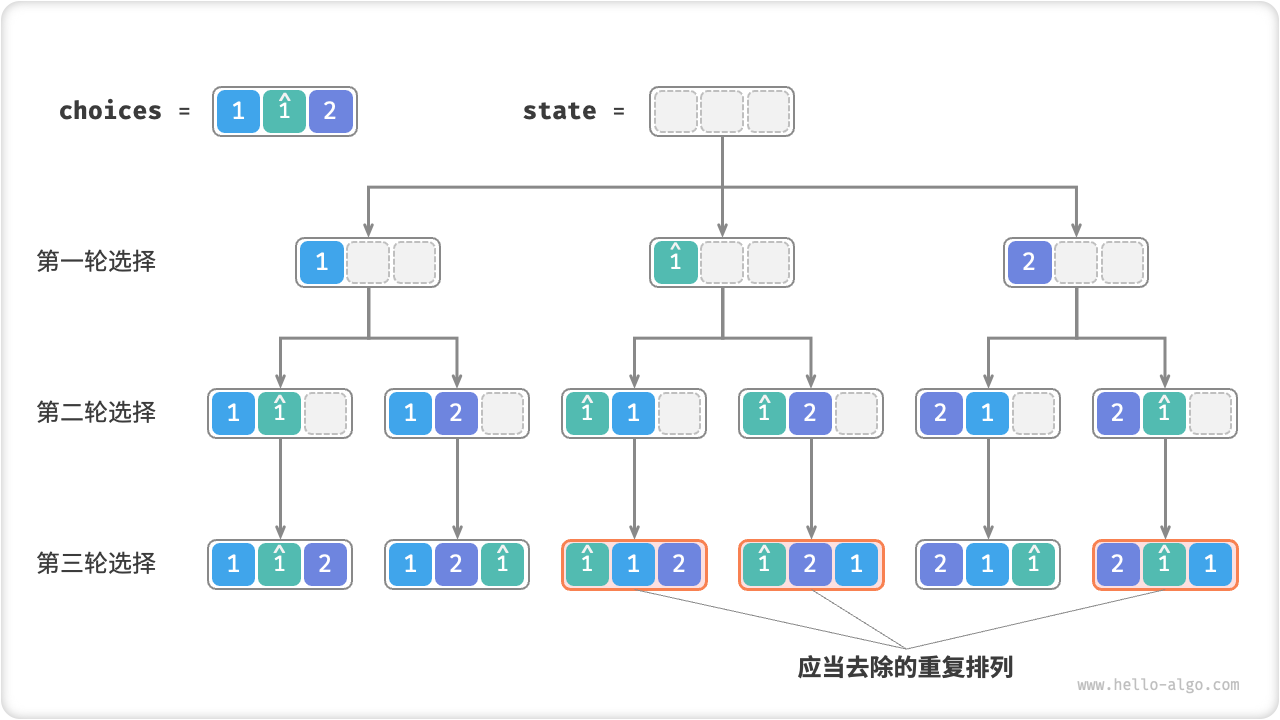
Fig. 重复排列
那么如何去除重复的排列呢?最直接地,考虑借助一个哈希表,直接对排列结果进行去重。然而这样做不够优雅,因为生成重复排列的搜索分支是没有必要的,应当被提前识别并剪枝,这样可以进一步提升算法效率。
相等元素剪枝¶
观察发现,在第一轮中,选择 \(1\) 或选择 \(\hat{1}\) 是等价的,在这两个选择之下生成的所有排列都是重复的。因此应该把 \(\hat{1}\) 剪枝掉。
同理,在第一轮选择 \(2\) 后,第二轮选择中的 \(1\) 和 \(\hat{1}\) 也会产生重复分支,因此也应将第二轮的 \(\hat{1}\) 剪枝。
本质上看,我们的目标是在某一轮选择中,保证多个相等的元素仅被选择一次。
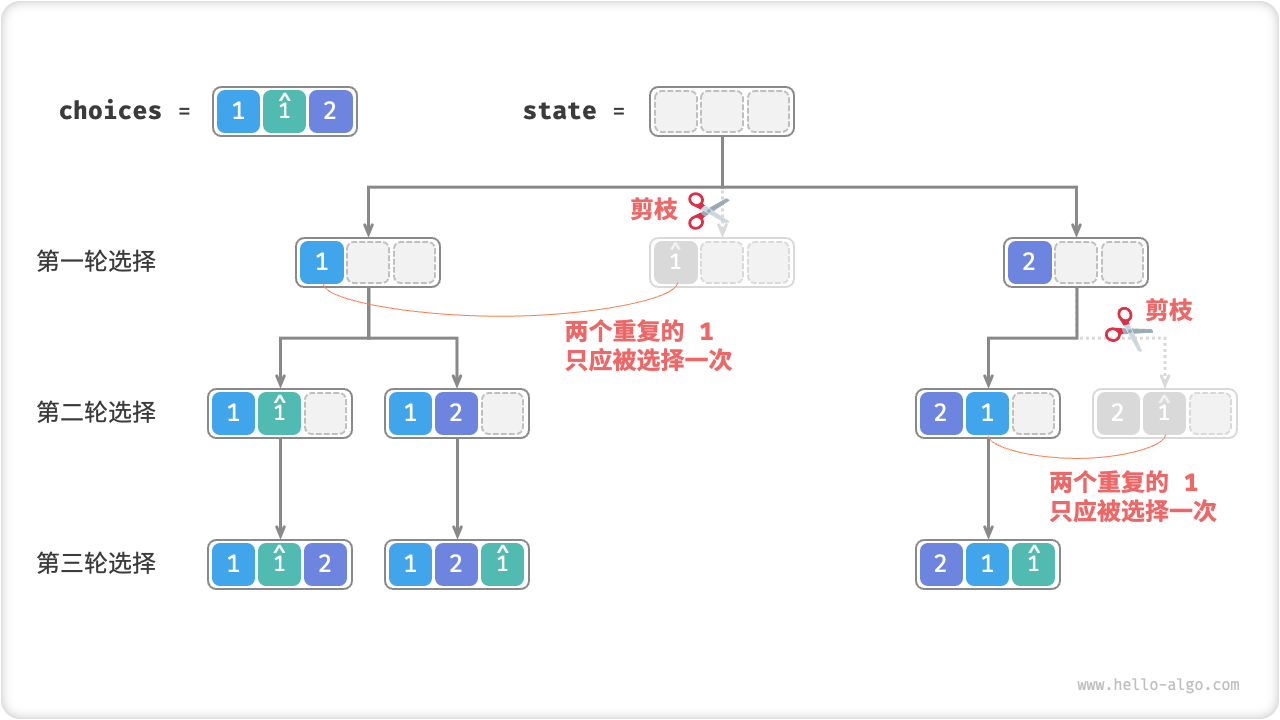
Fig. 重复排列剪枝
代码实现¶
在上一题的代码的基础上,我们考虑在每一轮选择中开启一个哈希表 duplicated ,用于记录该轮中已经尝试过的元素,并将重复元素剪枝。
/* 回溯算法:全排列 II */
void backtrack(List<Integer> state, int[] choices, boolean[] selected, List<List<Integer>> res) {
// 当状态长度等于元素数量时,记录解
if (state.size() == choices.length) {
res.add(new ArrayList<Integer>(state));
return;
}
// 遍历所有选择
Set<Integer> duplicated = new HashSet<Integer>();
for (int i = 0; i < choices.length; i++) {
int choice = choices[i];
// 剪枝:不允许重复选择元素 且 不允许重复选择相等元素
if (!selected[i] && !duplicated.contains(choice)) {
// 尝试:做出选择,更新状态
duplicated.add(choice); // 记录选择过的元素值
selected[i] = true;
state.add(choice);
// 进行下一轮选择
backtrack(state, choices, selected, res);
// 回退:撤销选择,恢复到之前的状态
selected[i] = false;
state.remove(state.size() - 1);
}
}
}
/* 全排列 II */
List<List<Integer>> permutationsII(int[] nums) {
List<List<Integer>> res = new ArrayList<List<Integer>>();
backtrack(new ArrayList<Integer>(), nums, new boolean[nums.length], res);
return res;
}
/* 回溯算法:全排列 II */
void backtrack(vector<int> &state, const vector<int> &choices, vector<bool> &selected, vector<vector<int>> &res) {
// 当状态长度等于元素数量时,记录解
if (state.size() == choices.size()) {
res.push_back(state);
return;
}
// 遍历所有选择
unordered_set<int> duplicated;
for (int i = 0; i < choices.size(); i++) {
int choice = choices[i];
// 剪枝:不允许重复选择元素 且 不允许重复选择相等元素
if (!selected[i] && duplicated.find(choice) == duplicated.end()) {
// 尝试:做出选择,更新状态
duplicated.emplace(choice); // 记录选择过的元素值
selected[i] = true;
state.push_back(choice);
// 进行下一轮选择
backtrack(state, choices, selected, res);
// 回退:撤销选择,恢复到之前的状态
selected[i] = false;
state.pop_back();
}
}
}
/* 全排列 II */
vector<vector<int>> permutationsII(vector<int> nums) {
vector<int> state;
vector<bool> selected(nums.size(), false);
vector<vector<int>> res;
backtrack(state, nums, selected, res);
return res;
}
def backtrack(
state: list[int], choices: list[int], selected: list[bool], res: list[list[int]]
):
"""回溯算法:全排列 II"""
# 当状态长度等于元素数量时,记录解
if len(state) == len(choices):
res.append(list(state))
return
# 遍历所有选择
duplicated = set[int]()
for i, choice in enumerate(choices):
# 剪枝:不允许重复选择元素 且 不允许重复选择相等元素
if not selected[i] and choice not in duplicated:
# 尝试:做出选择,更新状态
duplicated.add(choice) # 记录选择过的元素值
selected[i] = True
state.append(choice)
# 进行下一轮选择
backtrack(state, choices, selected, res)
# 回退:撤销选择,恢复到之前的状态
selected[i] = False
state.pop()
def permutations_ii(nums: list[int]) -> list[list[int]]:
"""全排列 II"""
res = []
backtrack(state=[], choices=nums, selected=[False] * len(nums), res=res)
return res
/* 回溯算法:全排列 II */
func backtrackII(state *[]int, choices *[]int, selected *[]bool, res *[][]int) {
// 当状态长度等于元素数量时,记录解
if len(*state) == len(*choices) {
newState := append([]int{}, *state...)
*res = append(*res, newState)
}
// 遍历所有选择
duplicated := make(map[int]struct{}, 0)
for i := 0; i < len(*choices); i++ {
choice := (*choices)[i]
// 剪枝:不允许重复选择元素 且 不允许重复选择相等元素
if _, ok := duplicated[choice]; !ok && !(*selected)[i] {
// 尝试:做出选择,更新状态
// 记录选择过的元素值
duplicated[choice] = struct{}{}
(*selected)[i] = true
*state = append(*state, choice)
// 进行下一轮选择
backtrackI(state, choices, selected, res)
// 回退:撤销选择,恢复到之前的状态
(*selected)[i] = false
*state = (*state)[:len(*state)-1]
}
}
}
/* 全排列 II */
func permutationsII(nums []int) [][]int {
res := make([][]int, 0)
state := make([]int, 0)
selected := make([]bool, len(nums))
backtrackII(&state, &nums, &selected, &res)
return res
}
/* 回溯算法:全排列 II */
function backtrack(state, choices, selected, res) {
// 当状态长度等于元素数量时,记录解
if (state.length === choices.length) {
res.push([...state]);
return;
}
// 遍历所有选择
const duplicated = new Set();
choices.forEach((choice, i) => {
// 剪枝:不允许重复选择元素 且 不允许重复选择相等元素
if (!selected[i] && !duplicated.has(choice)) {
// 尝试:做出选择,更新状态
duplicated.add(choice); // 记录选择过的元素值
selected[i] = true;
state.push(choice);
// 进行下一轮选择
backtrack(state, choices, selected, res);
// 回退:撤销选择,恢复到之前的状态
selected[i] = false;
state.pop();
}
});
}
/* 全排列 II */
function permutationsII(nums) {
const res = [];
backtrack([], nums, Array(nums.length).fill(false), res);
return res;
}
/* 回溯算法:全排列 II */
function backtrack(
state: number[],
choices: number[],
selected: boolean[],
res: number[][]
): void {
// 当状态长度等于元素数量时,记录解
if (state.length === choices.length) {
res.push([...state]);
return;
}
// 遍历所有选择
const duplicated = new Set();
choices.forEach((choice, i) => {
// 剪枝:不允许重复选择元素 且 不允许重复选择相等元素
if (!selected[i] && !duplicated.has(choice)) {
// 尝试:做出选择,更新状态
duplicated.add(choice); // 记录选择过的元素值
selected[i] = true;
state.push(choice);
// 进行下一轮选择
backtrack(state, choices, selected, res);
// 回退:撤销选择,恢复到之前的状态
selected[i] = false;
state.pop();
}
});
}
/* 全排列 II */
function permutationsII(nums: number[]): number[][] {
const res: number[][] = [];
backtrack([], nums, Array(nums.length).fill(false), res);
return res;
}
/* 回溯算法:全排列 II */
void backtrack(List<int> state, int[] choices, bool[] selected, List<List<int>> res) {
// 当状态长度等于元素数量时,记录解
if (state.Count == choices.Length) {
res.Add(new List<int>(state));
return;
}
// 遍历所有选择
ISet<int> duplicated = new HashSet<int>();
for (int i = 0; i < choices.Length; i++) {
int choice = choices[i];
// 剪枝:不允许重复选择元素 且 不允许重复选择相等元素
if (!selected[i] && !duplicated.Contains(choice)) {
// 尝试:做出选择,更新状态
duplicated.Add(choice); // 记录选择过的元素值
selected[i] = true;
state.Add(choice);
// 进行下一轮选择
backtrack(state, choices, selected, res);
// 回退:撤销选择,恢复到之前的状态
selected[i] = false;
state.RemoveAt(state.Count - 1);
}
}
}
/* 全排列 II */
List<List<int>> permutationsII(int[] nums) {
List<List<int>> res = new List<List<int>>();
backtrack(new List<int>(), nums, new bool[nums.Length], res);
return res;
}
/* 回溯算法:全排列 II */
func backtrack(state: inout [Int], choices: [Int], selected: inout [Bool], res: inout [[Int]]) {
// 当状态长度等于元素数量时,记录解
if state.count == choices.count {
res.append(state)
return
}
// 遍历所有选择
var duplicated: Set<Int> = []
for (i, choice) in choices.enumerated() {
// 剪枝:不允许重复选择元素 且 不允许重复选择相等元素
if !selected[i], !duplicated.contains(choice) {
// 尝试:做出选择,更新状态
duplicated.insert(choice) // 记录选择过的元素值
selected[i] = true
state.append(choice)
// 进行下一轮选择
backtrack(state: &state, choices: choices, selected: &selected, res: &res)
// 回退:撤销选择,恢复到之前的状态
selected[i] = false
state.removeLast()
}
}
}
/* 全排列 II */
func permutationsII(nums: [Int]) -> [[Int]] {
var state: [Int] = []
var selected = Array(repeating: false, count: nums.count)
var res: [[Int]] = []
backtrack(state: &state, choices: nums, selected: &selected, res: &res)
return res
}
/* 回溯算法:全排列 II */
fn backtrack(mut state: Vec<i32>, choices: &[i32], selected: &mut [bool], res: &mut Vec<Vec<i32>>) {
// 当状态长度等于元素数量时,记录解
if state.len() == choices.len() {
res.push(state);
return;
}
// 遍历所有选择
let mut duplicated = HashSet::<i32>::new();
for i in 0..choices.len() {
let choice = choices[i];
// 剪枝:不允许重复选择元素 且 不允许重复选择相等元素
if !selected[i] && !duplicated.contains(&choice) {
// 尝试:做出选择,更新状态
duplicated.insert(choice); // 记录选择过的元素值
selected[i] = true;
state.push(choice);
// 进行下一轮选择
backtrack(state.clone(), choices, selected, res);
// 回退:撤销选择,恢复到之前的状态
selected[i] = false;
state.remove(state.len() - 1);
}
}
}
/* 全排列 II */
fn permutations_ii(nums: &mut [i32]) -> Vec<Vec<i32>> {
let mut res = Vec::new();
backtrack(Vec::new(), nums, &mut vec![false; nums.len()], &mut res);
res
}
假设元素两两之间互不相同,则 \(n\) 个元素共有 \(n!\) 种排列(阶乘);在记录结果时,需要复制长度为 \(n\) 的列表,使用 \(O(n)\) 时间。因此,时间复杂度为 \(O(n!n)\) 。
最大递归深度为 \(n\) ,使用 \(O(n)\) 栈帧空间。selected 使用 \(O(n)\) 空间。同一时刻最多共有 \(n\) 个 duplicated ,使用 \(O(n^2)\) 空间。因此空间复杂度为 \(O(n^2)\) 。
两种剪枝对比¶
请注意,虽然 selected 和 duplicated 都用作剪枝,但两者的目标不同:
- 重复选择剪枝:整个搜索过程中只有一个
selected。它记录的是当前状态中包含哪些元素,作用是避免某个元素在state中重复出现。 - 相等元素剪枝:每轮选择(即每个开启的
backtrack函数)都包含一个duplicated。它记录的是在遍历中哪些元素已被选择过,作用是保证相等元素只被选择一次。
下图展示了两个剪枝条件的生效范围。注意,树中的每个节点代表一个选择,从根节点到叶节点的路径上的各个节点构成一个排列。
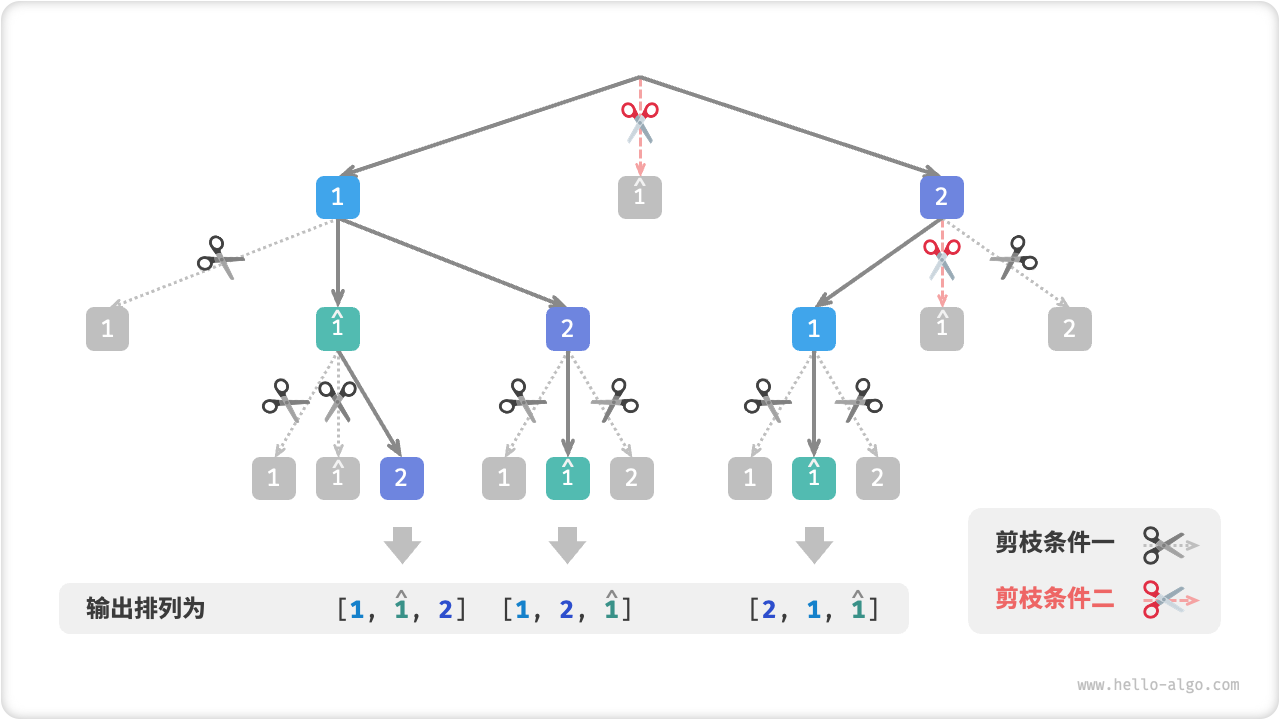
Fig. 两种剪枝条件的作用范围